| Introduktion
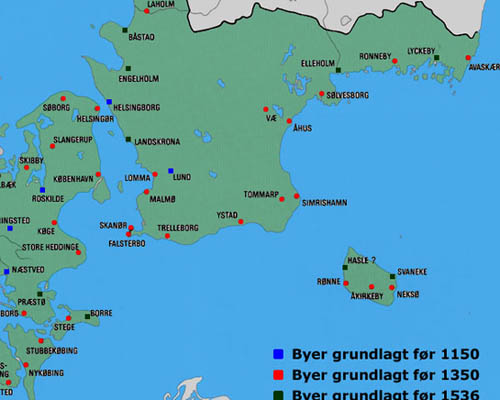
| | I løbet af 1200-tallet opstår de første egentlige byer i Øresundsregionen og en voksende handel med fødevarer, hvor Skånemarkedet og købstæderne i Øresund bliver et knudepunkt.
Perioden er også præget af forandringerne i den sociale struktur og den voldsomme befolkningsnedgang i forbindelse med pesten (Den sorte Død) i midten af 1300-tallet. |
Omkring år 1250 er grundstrukturerne i det kristne, middelalderlige feudalsamfund etableret. Landskabslovene, nedskrevet omkring midten af 1200-tallet, vidner om ændringer i den sociale struktur, med gradvis ophævelse af trællevæsen og indførelse af fæsteforhold.
Efterhånden etableres et hierarkisk opbygget standssamfund, hvilende på et system af gensidige rettigheder og forpligtigelser, hvor adelen fremstår som en privilegeret stand med lensrettigheder og en forfinet ridderkultur.
Perioden er også præget af krisetider og magtkampe imellem konge, kirkemagt og adel. Fra omkring 1300 er der krisetider med økologisk ubalance, klimatiske ændringer, misvækst og pestens hærgen fra ca.1350 til 1400.
I løbet af 1200-tallet opstår de første egentlige byer og en voksende handel med fødevarer, hvor Skånemarkedet og købstæderne i Øresund bliver et knudepunkt. Kongemagten rivaliserer vedvarende med Hansestæderne om dominansen over handelen.
Den kulturelle påvirkning kommer fortrinsvis fra det nordtyske område, hvor bykulturen blomstrer i Hansestæderne. Stilhistorisk sker der et skifte til den gotiske byggestil og markante ændringer i religionsopfattelse og verdensanskuelse finder sted.Feudalismen
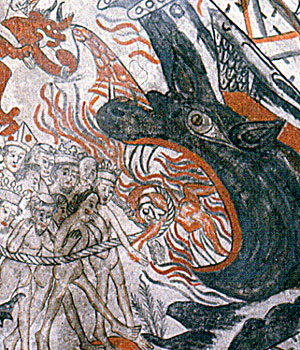
| | Ifølge kirkens budskab stod alle lige over for Gud, og alle kunne risikere at komme i helvede, som det ses på kalkmaleriet fra Tuse kirke.
Sålænge man levede på jorden kunne det dog være vanskeligt at få øje på ligheden. Konge, adel og højgejstlige udgjorde en snæver overklasse. Heroverfor stod bondestanden, over 90% af befolkningen. Med byvæksten opstod efterhånden en ny klasse: borgerstanden. |
Den sociale struktur
I løbet af højmiddelalderen sker der en omfattende ændring i landets sociale struktur. Kendetegnet for den europæiske feudalismes hierarkiske opbygning, hvor konge, kirke og adel (hærmændene) står øverst og ca. 90 % af befolkningen nederst kommer til at fungere helt frem til 1800-tallets begyndelse.
Ejendomsretten til Danmarks jord bliver i perioden delt mellem overklassens tre hovedaktører, der uddeler brugsretten, med tilhørende afgifter af forskellig art, til et voksende antal af fæstebønder.
For at forstå dette kan man begynde med at se på udviklingen i herremands-standen.
Herremændene og lens og vasalforholdet
Hærmændene, heraf udtrykket ”herremand” udgjorde, retslig set, kun én gruppe/stand, men socialt var standen ikke særlig homogen. I levevis var der stor forskel på de jorddrotter, der ejede flere borge og hovedgårde samt strøgods og den simple adelsmand, landsbyvæbneren, der ikke ravede langt op over storbøndernes niveau.
Som navnet antyder er det en militær titel. Herremændene beskyttede landet ved at stille rytterhære til rådighed for kongen og fik som belønning herfor skattefrihed for deres jorde. Et væsentligt incitament til at tilknytte og fastholde arbejdskraft til de store godser.
Fra midten af 1200-tallet vandt det europæiske riddervæsen indpas i Danmark, hvor det blev en ærestitel for de få, der havde modtaget ridderslaget.
Kongens afhængighed af denne rytteradel betød, at de som betaling for deres tjenester fik lov til, mod en afgift, at ”låne”, heraf navnet ”lehn”, større eller mindre landområder, der tilhørte kongeriget. Her blev de selv småkonger/fyrster og afgifterne fra områdets fæstebønder gik ubeskåret til dem selv. Man kaldte dette for et lens og vasalsystem, hvor kongen var lensherren og herremanden vasal. Et kompliceret system, der dominerede i det meste af Europa.
Adelens pantelen blev på et tidspunkt så omfattende i 1300-tallets Danmark, at hele landet var opdelt i pantelen. Panthavernes magt understreges af, at de i perioden 1332-1340, undlod at besætte kongetronen!
Den tiltagende godssamling for de store herremænd nødvendiggjorde en større arbejdsstyrke. For eksempel ved at inddrage trællene på en mere effektiv måde og selvejerbønderne i produktionen. En bestræbelse som både kronen og kirkens ejere af kirkegodet også fandt relevant.

Fornemt gæstebud. | 
Musikanter. |
Gejstlighed/Biskopperne og præsterne
De gejstlige var delt i forskelligartede sociale grupper, spændende fra biskopperne, der fremstod som jordejere på linie med adelen, til den almindelige præst, der, på det nærmeste, delte bøndernes vilkår.
Efterhånden voksede kirke og klostergodset til et anseeligt omfang. For eksempel på Sjælland og i Skåne.
For både konge, kirke, og adel gjaldt dog, at den nødvendige og motiverede arbejdskraft var til stede. Og her stillede trællevæsenets forældede produktionsform sig i vejen. Trællen burde blive til fæster.

Biskop |
Fra træl til fæstebonde
I tidlig middelalder bar Danmark endnu præg af at være et slavesamfund. Landskabslovene, som blev nedskrevet i første halvdel af 1200-tallet, vidner således om et samfund, hvor der blev skelnet skarpt mellem frie og ufrie mennesker. De ufrie, trællene, som de kaldtes i Danmark, var ofte rekrutteret blandt krigsfanger og udgjorde bunden af samfundet, hvor de var helt uden rettigheder. Her har de udført det hårdeste arbejde f.eks. skovrydningerne og deltaget i det omfattende kirkebyggeri.
Trællenes manglende motivation i det daglige arbejde kom i stærk modsætning til behovet for nyopdyrkning af overklassens jord. Ved at give trællene brugsret til jorden mod en afgift til jordejeren, hvad enten denne var kronen, herremanden eller kirken, fik trællen selv interesse i at arbejde. En del af trællene blev derfor til fæstebønder.
En anden vigtig faktor ved trællevæsenets gradvise ophør var kirkens forbud mod at gøre kristne til trælle. Dette mindskede tilgangen af trælle, der medførte, at priserne på disse steg.
Fra selvejer til fæster
Eftersom kirkens og adelens jorde var skattefrie blev det mere almindeligt at selvejerbønderne overlod deres jorder til kirken og herremændene for at få værn, beskyttelse og skattefrihed. De blev altså fæstebønder og betalte istedet afgifter til deres nye herrer.
I slutningen af perioden anslår man, at selvejerbønder kun udgjorde 10% af befolkningen i Danmark mod 52% i Sverige. En udvikling der fortsatte; i 1600-tallet udgjorde selvejerbønderne således kun ca. 6% af befolkningen.
Fæstebønder og "vornedskab"
Arbejdskraftmangelen fra omkring år 1300 synes at være til fordel for fæstebønderne, idet der er problemer med at besætte gårdene. Der opstår såkaldte ødegårde og disses antal vokser i krisetiderne efter år 1300 og i særdeleshed efter Den sorte Døds hærgen omkring 1350, hvor områder der tidligere var opdyrket springer i skov.
For at dæmme op for fæstebøndernes flugt fra gårdene indførtes det såkaldte vornedskab på Sjælland og Lolland-Falster. Dette indebar, at fæstebønderne ikke måtte fraflytte godset og i realiteten blev livegne.
En vigtig årsag til, at det var på Sjælland og øerne at vornedskabet blev gennemført skal søges i den enorme tiltrækning fra Skånemarkedes sildefiskeri. Datidens jorddyrkere i disse områder var en slags amfibier, der kunne begå sig både til lands og i vands.
Det er dog først fra 1400-tallets midte, at der kan findes skriftligt kildebelæg i lovstoffet: Laalands vilkår af 1446 art.11.
Borgerskabet
Borgerskabet var i højmiddelalderen en ret beskeden gruppe, som dog voksede med den stigende handel og omsætning i perioden. En udvikling der betød at dele af landbefolkningen søgte mod de voksende købstæder.
Højmiddelalderens bondestand
Til forskel fra den tidlige middelalders bondesamfund ser vi nu, at: Tidligere trælle har vundet frihed og er optaget i bondestandens nederste lag. Bondestanden er dog en meget sammensat og bevægelig gruppe, bestående af:
-Selvejerbønder (i et ringe antal)
-Fæstebønder
-Gårdsæder eller husmænd, der ikke havde del i landsbyens dyrkede jord og derfor måtte arbejde for andre
-Tyende, der måtte bo og tjene deres brød i andres husholdning.
tilsyneladende bedre vilkår, bl.a. som følge af mangel på arbejdskraft.

Adam på arbejde. | 
Eva spinder. |
Standssamfundet tager form.
Efterhånden bliver den sociale struktur mere enkel. Med etableringen af fæsteforholdet begynder middelaldersamfundet at antage en mere fast struktur, et standssamfund med en hierarkisk opbygning, hvor kongemagten er toppen af en pyramide bestående af gejstlighed, adel, borgere og bønder.
Kongen
1.stand: gejstligheden
2.stand: adelen
3.stand: borgere
4.stand: bønder
 Feudalsamfundet Krisetider
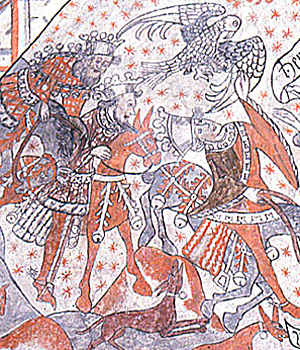
| | Den tidlige middelalders vækst og ekspansion ophører henimod år 1300.
Misvækst, klimaforandring og økologisk krise kulminerer med politiske kriser og Den sorte Døds hærgen i tiden omkring 1350.
Både kongemagten og kirken bygger omfattende borganlæg som værn mod ydre fjender, men også i tilfælde af indbyrdes konflikter. |
Krisens karakter
Den vækst- og ekspansionsperiode der prægede den tidlige middelalder ophører i tiden omkring 1250. Efter en lang periode med nyopdyrkning af jord og udflytning fra de etablerede landsbyer har der antageligt ikke længere været mulighed for at opdyrke og kultivere nye jorder og i 1300-tallet er der ligeledes tydelige tegn på overudnyttelse af ressourcerne. Ekspansionen har medført fældning af store skovområder og anvendelsen af store mængder træ til bygninger, indhegning af dyrkede områder og markskel har betydet rovdrift på skoven og problemer med sandflugt rundt omkring i landet.
Det er vanskeligt at give en udtømmende forklaring på omslaget, men formodentlig har ekspansionen nået en vis naturlig grænse og man konstaterer også et fald i befolkningstallet. En generel økologisk krise kombineret med år med misvækst og klimaforandring i form af temperatur falder det generelle billede, der tegner sig. Hertil kommer så endelig sygdomsepidemier, kulminerende med Den Sorte Død i sidste halvdel af 1300-tallet, hvor anslået 25 % af befolkningen omkommer.
Den politiske krise
Krisen medfører et fald i befolkningstallet, betydelige forandringer i befolkningens sammensætning og status og også ændringer i de politiske magtforhold. Kongen er fortsat rigets overhoved, men hans magtudøvelse finder efterhånden sted i samråd med en aristokratisk klasse af herremænd, som udgør samfundets krigerkaste. Herremændene er blevet styrket i en proces, hvor fyrstelenene bliver arvelige og krigstjenesten begrænses. F.eks. erstattes 1313 det kongelige ledingsudbud i Slesvig af hertugens pligt til at stille med 50 ryttere i krigstid.
Bispelenene stræber også efter øget suverænitet og selvbestemmelse og det giver anledning til konflikter imellem kongemagten og ærkebiskopperne Jacob Erlandsen(død 1274), der vælges udenom kongen i 1252, og senere Jens Grand(valgt 1289). Disse konflikter fører til at riget pålægges interdikt ikke mindre end tre gange. Det er dog tvivlsomt om pavens forbud mod at forrette de kirkelige handlinger har haft nogen reel virkning.
Borgbyggeri
Et synligt vidnesbyrd om de urolige og omskiftelige tider omkring år 1300 var kronens anlæggelse og fornyelse af en række borganlæg rundt omkring i regionen.
Ved Helsingborg afløstes det oprindelige cirkulære tårn med det firkantede og 30 meter høje Kärnan. Denne tårnbygning blev en massiv og sværindtagelig borg. Den nederste del af tårnet var således over 4 meter tyk. Et forsvarsanlæg der kunne stå mål mod tidens selv stærkeste våben. Arbejdet blev iværksat omkring 1310, i Erik Menveds tid, hvor også Falsterbohus og Lindholm længere sydpå i Skåne blev udbygget og forstærket. Falsterbohus fik også et kvadratisk kernetårn og det samme var tilfældet med Lindholmes borg ved Börringesjön i det sydlige Skåne. Falsterbohus overtog efterhånden Skanørborgens opgaver og Helsingborg, med det nye Kärnan, udviklede sig til at blive kronens vigtigste forsvarsværk i Skåne.
På Bornholm udvikles Hammershus efterhånden til det største borganlæg i Norden. I Vordingborg på Sydsjælland opføres et borgkompleks til forsvar af landets sydgrænse og i Kalundborg på Vestsjælland udbygges Esbern Snares gamle borganlæg. Endelig opføres i Nordsjælland i Valdemar Atterdags tid(1340-1375) et administrativt centrum med et centralt borganlæg ved Gurre.

Borge før 1400 | 
Kärnan, Helsingborg | 
Kärnan i snit | 
Kärnans indre | 
Hammershus |

Gåsetårnet. | 
Vordingborg Slot. | 
Borganlæg | 
Gurre Slotsruin | 
Gurreudgravning |

Gurrekompleks | 
Gurre Slot |
Kongemagtens svækkelse
Med lensherrernes øgede selvbestemmelse og den tiltagende feudalisering sker der en forskydning af magtudøvelsen hen imod det lokale plan og i forbindelse hermed en formindskelse og konsolidering af herremandsstanden. Kongemagten svækkes yderligere af dalende indtægter, selvom det i nogen grad kompenseres af indtægterne fra Skånemarkedet, hvor man dog må kæmpe med de tyske hansestæders dominans over handelen.
I tiden efter Valdemar Sejrs død i 1241 plages landet af dynastiske stridigheder og Erik Klipping(1259-1286) må som den første konge i 1282 underskrive en håndfæstning, en kontrakt som nøje fastlægger hans virkefelt: Kongen forpligter sig bl.a. til en gang om året at indkalde til danehof på et centralt sted i riget og hans juridiske råderum begrænses. I 1320 bekræfter kong Christoffer 2. i sin håndfæstning endvidere kirkens skattefrihed og domsmyndighed.
I 1318 falder svenskerne hærgende ind i Skåne og fra 1343-1360 er Skånelandene på svenske hænder I 1330 nedlægger Valdemar d.3. kronen og vender tilbage til sit hertugdømme i Slesvig. I en kort periode fra omkring 1332-1340 er kongetronen ligefrem ubesat og riget bl.a. pantsat til de holstenske grever Gerhard og Johan, men under Valdemat 4. Atterdag(1340-75) lykkes det at indfri gælden og reetablere riget.
Kampen mod Hansaen
Først omkring 1360 kan man igen for alvor hævde sig overfor den tyske indflydelse. Hansestaden Visby på Gotland erobres i 1361 og hansestæderne pålægges store afgifter i Skåne. Hansestædernes modtræk bliver dannelsen af Det store Hanseforbund i 1367 og et fælles angreb på Danmark, hvori også Mecklenburg, Sverige og en række holstenske grever og danske stormænd deltager.
I 1368 erobres de fleste forsvarsborge langs kysterne og i 1369 den stærke fæstning ved Helsingborg. Danskerne må søge fred og ved fredsslutningen i Stralsund i 1370 må man afgive 2/3 af afgifterne fra Skånemarkedet og som sikkerhed herfor overlade de skånske borge til Hansestæderne i 15 år.

Massedrab | 
Kranieskud |
Kalmarunionen
Under Valdemar Atterdags efterfølger og datter Margrethe 1.(1375-97) bliver riget reetableret og der indgås ovenikøbet en union imellem de nordiske lande. Samtidig formår Margrethe også at stække adelen, bl.a. gennem forbud imod opførelse af private borganlæg. Et forbud der opretholdes helt fem til 1397.
Margretes efterfølger, Erik af Pommern, regerer et samlet Norden under Kalmarunionens banner frem til 1439, hvor han bliver fordrevet og ender karrieren som sørøver på Gotland. Han så det som en væsentlig politisk opgave at styrke Øresundsregionen og indførte bl.a. Øresundstolden i 1429.

Søborg Slot | 
Margrehe 1. | 
Gjorslev Slot | 
Erik af Pommern | 
Dalowo |
Esrum Kloster
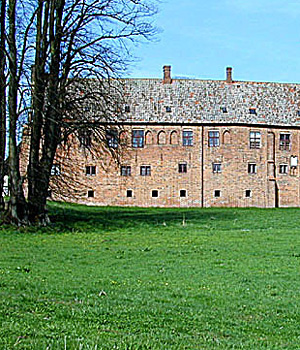
| | Esrum kloster bliver i løbet af middelalderen den største jordbesidder i Nordsjælland.
Den tidlige middelalders stordrift på såkaldte grangier med lægbrødres arbejdskraft afløses af et system med brydegårde med tilknyttet arbejdskraft i skikkelse af gårdsæder (husmænd) og landboer (fæstebønder). |
Esrum Kloster i Nordsjælland blev etableret som cistercienserkloster i 1151 og knyttes til hovedklosteret Clairveaux i Frankrig, opkaldt efter reformatoren Bernard af Clairveaux. Endnu i dag aner man klosterets ideelle beliggenhed, isoleret på en flad strækning tæt ved Esrum Sø og op til åen, der kunne forsyne klosteret med drikkevand og vandkraft. Esrum Kloster blev fra starten begunstiget med gaver i form af jord og ejendom og udviklede sig i løbet af 1200-tallet til den største jordejer i Nordsjælland.

Esrum Kloster | 
Vandvejen | 
Esrums beliggenhed | 
Bernhard af Clairvaux |
Bryde- og fæstegårde
I en første periode frem til midten af 1200-tallet blev vægten lagt på produktion på store avlsgårde, såkaldte grangier, der blev drevet af munkene og klosterets lægbrødre. Disse fungerede primært som klostrets håndsarbejdere og deltog kun i begrænset omfang i klosterlivet. Lægbrødre- ordningen har formodentlig også været et værn mod fattigdom i tider med rigelig arbejdskraft.
Cistercienserordenen skulle ikke betale tiende og den jord som munkene arvede og selv dyrkede var i det hele taget fritaget for skat, så grangiesystemet har været givtigt og fordelagtigt. Fra omkring midten af 1200-tallet bliver det svært at hverve lægbrødre og man begyndte at afvikle grangierne til fordel for brydegårde, gårde med bestyrere og tilknyttede gårdsæder(husmænd). Omkring dette tidspunkt ophæves endvidere en intern regel om at ordenes jord ikke må bortfæstes og herefter følger også oprettelse af fæstegårde med landboere(fæstebønder).
Dyrkningsstrukturen
Dyrkningsstrukturen med brydegårde og 3-vangsbruget eksisterede i hvert fald i den vestlige del af Nordsjælland, Holbo Herred, hvor den bedste jord befandt sig. I øvrigt må man i Nordsjælland forestille sig en meget varieret produktion med udgangspunkt i en slags skovlandbrug, hvor, som tidligere nævnt, adskillelsen imellem agerland og skov var flydende og høslæt og græsning for dyrene har spillet en hovedrolle.
Produktion og kost
Naturalielandgildens sammensætning og klosterbesiddelsernes beliggenhed i Nordsjælland viser en tendens til at den vegetabilske produktion dominerer i de nordlige og vestlige dele, mens den animalske produktion dominerer omkring Nødebo i bunden af Esrum Sø, hvor der har været engdrag til græsning omkring søen. På Nordkysten omkring Hornbæk spillede fiskeproduktionen en vis rolle.
Det er imidlertid vanskeligt at sige noget præcist om levevilkår og ernæring, men en enkelt kilde, den såkaldte "Skånske ledingsret", oplyser indirekte om kostens sammensætning.

Esrums produktion |
Klosterets besiddelser
Esrumklosters besiddelser strakte sig helt ud til Øresundskysten, hvor udnyttelse af vandkraft til møller fandt sted omkring det nuværende Egebæksvang.
Klosterets besiddelser begrænsede sig imidlertid ikke kun til Sjælland. Foruden de ialt 311 fæstegårde man besad, ejede klosteret en hovedgård og 45 fæstegårde i Halland. og et ukendt antal gårde i Skåne. Endvidere besad klosteret en mølle i Helsingborg og samme sted 2 boder, som man havde fået testamenteret som gave.
I Halland havde man interesser i tømmer, bl.a. egetræ, der allerede i 1100-tallet var ved at blive en mangelvare på Sjælland.Handel og byer
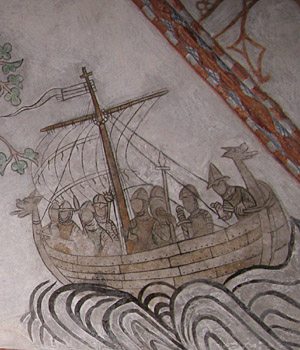
| | Middelalderens handelsruter tager udgangspunkt i vikingetidens handelsveje.
Efterhånden forbedres teknologi og lasteevne betydeligt og koggen afløser vikingetidens både af knartypen.
Regionens overskud af primært fødevarer omsættes i et kompliceret samhandelsmønster, der også danner udgangspunkt for vækst i bysamfundene. |
Helt tilbage i forhistorisk tid har der fundet handel sted imellem Norden og Sydeuropa og i sen jernalder og tidlig vikingetid er bl.a. rav, pelsværk og slaver blevet solgt og byttet for luksusvarer som f.eks. glas sydfra.
I 700–tallet blev handelen imellem Middelhavet og Nordeuropa bl.a. formidlet via Frankerriget, men da det bukker under i starten af 800-tallet og araberne erobrer store dele af middelhavsområdet kommer Norden i vikingetiden til at spille en fremtrædende rolle i både nord-syd og øst-vest handelen. I det sydlige Skandinavien bliver Hedeby i Sønderjylland et fremtrædende handelscentrum, mens det længere øst og nordpå er Gotland og Birka i Sverige.

Handelsveje |
Skibstyper
Først og fremmest var det vikingernes skibsteknologi der fra omkring år 800 sikrede dem en fortrinsstilling i østersøhandelen. Man må forestille sig at stormænd og bønder udrustede skibe til togter i langskibe der kunne laste ca. 9 tons.
De senere udviklede, men også klinkbyggede skibe af knartypen, som man også anvendte til sejlads på Nordatlanten, kunne laste omkring 20 tons.
I starten af perioden har det nok været vanskeligt at skelne imellem plyndrings- handels- og kolonisationstogter, men på overgangen til middelalderen omkring år 1050 spiller handelen en mere fremtrædende rolle. Det sidste især takket være den nye skibstype koggen, der med sit høje kravelbyggede skrog kunne laste op imod 30 ton, og omkring år 1200 helt op imod 200 tons.

Kogge og Knar | 
Knar | 
Kogge. | 
Malmøkoggen | 
Model |

Hork |
Varetyper
Fra omkring dette tidspunkt begynder handelen også at skifte til mere dagligdags varer, såsom korn, fisk og kød, som bl.a. stammer fra den overskudsproduktion som de nye dyrkningsmetoder tilvejebringer. Disse produkter kunne afsættes i de bysamfund, som i løbet af 11- og 1200-tallet blomstrer op i Nordtyskland. Disse hansestæder, som de efterhånden benævnes, kommer i den efterfølgende tid til at beherske store dele af handelen på Østersøen i kraft af organisatorisk og teknologisk overlegenhed.
Byudviklingen
Byudviklingen i begyndelsen af middelalderen er af behersket karakter. Hedeby mister sin fremtrædende rolle og Lübeck er omkring 1300 blevet handelscentrum i bunden af Østersøen. I Danmark var der omkring 1150 kun ca. 20 byer i alt og selvom antallet i 1250 var steget til omkring 60 var de af meget beskeden karakter, ofte lokaliseret i nærheden af borganlæg, som indbyggerne kunne søge ly hos i urolige tider med krig, eller sørøveri. De mange byer med endelsen -borg, f.eks. Helsingborg, Vordingborg vidner herom.
Spørgsmålet om, hvordan byerne i middelalderen opstår og udvikler sig er stadigvæk genstand for debat. Det kan, som nævnt ovenfor, ske på foranledning af kongemagten og som regel også i sammenhæng med handel og begyndende serieproduktion.

Købstæder | 
Lübeck | 
Visby | 
Byport |
Tidlige byer
Byerne Lund, Helsingborg i Skåne og Roskilde på Sjællandsiden er grundlagt før 1150. Af disse kan i hvert fald Lunds opståen føres tilbage til 1000-tallet. Allerede under Knud den Store(1018-1035) udviklede Lund sig til det mest betydningsfulde møntsted i Danmark og håndværksaffald viser tegn på serieproduktion i slutningen af 1000 og starten af 1100-tallet.
De fleste byer er grundlagt før 1350. En del af dem som f.eks. Næstved, Ringsted og Sorø ligger inde i landet, mens andre, typisk -borgbyerne, ligger ud til kysten og har forbindelse til den stigende handel og produktion langs kysterne. De fleste af borgbyerne er placeret i den sydlige del af regionen, vendt imod det tyske område. Det afspejler også den politiske og kulturelle orientering i højmiddelalderen. Byer anlagt senere ligger hovedsagelig omkring Øresund.Skånemarkedet
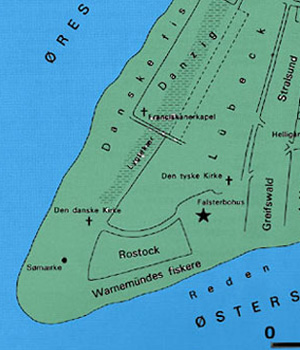
| | Sildefiskeriet omkring Skanør-odden og det dertil knyttede Skånemarked udgør et vigtigt økonomisk center i Øresunds- og Østersøregionen.
For kongemagten betyder det en væsentlig indtægtskilde. I gode år i 1300-tallet blev der årligt produceret op til 300.000 tønder sild årligt. |
Selvom byudviklingen var beskeden set i forhold til hansestædernes vækst havde det danske rige dog afgjorte fordele af væksten i landbrugsproduktionen og sildefiskeriet, der om efteråret forgik langs Øresunds kyster. Især Skanør-fiskeriet og det dertil knyttede Skånemarked var af stor økonomisk betydning for den danske kongemagt. Skanør og Falsterbo var dog helt specielt ved sin tidsbegrænsede aktivitet, hvor fiskeriet foregik i efterårsmånederne og markedet knyttede sig hertil. I denne periode boede og arbejdede udlændinge og lokale på området.

Skånemarkedet | 
Sildefiskeri | 
Skanør kirke | 
Borganlæg |
Sildefiskeriets betydning
Allerede i 1000-tallet er der beretninger om store mængder af sild i Øresund, men først i katolsk tid med kødløse fredage og fastedage og nedsaltning med salt fra Lüneburger Heide bliver silden den vigtigste eksportvare. I gode år i 1300-tallet kunne der årligt produceres og eksporteres op til 300.000 tønder årligt og det anslås at omkring en tredjedel af den danske krones indtægter stammede fra indtægterne af skånemarkedet og det bliver da også det vigtigste marked i Øresunds- og Østersøregionen.
Hansaens interesser.
Hanseaternes magt over østersøhandelen aftager omkring år 1300. Allerede i 1250 havde de første ummelandsfarere, folk fra Nederlandene og England der sejlede ummeland, dvs. nord om Jylland og ned igennem Sundet for at komme ind i Østersøen, vist sig på Skånemarkedet. Hanseaterne anvender deres kontrol over Skånemarkedet i perioden 1368-85 til at udelukke omlandsfarerne, men disse kan nu med de mere veludviklede skibstyper sejle direkte til destinationer langt inde i Østersøen. Desuden finder hollænderne ud af at fiske sild i Nordsøen, således at man helt kan undvære Skånemarkedet. Hertil kommer endelig at sildefiskeriet i Sundet kulminerer hen imod slutningen af 1300-tallet.Kalkmalerier
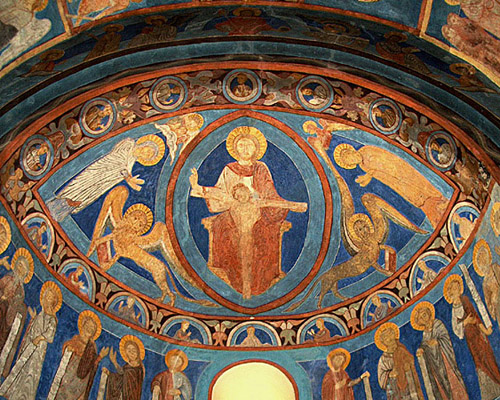
| | I tidlig middelalder var Majestas Domini-motivet, med Krisus tronende som himmelkongen dominerende.
I Højmiddelalderen blev forskellige Maria-motiver almindelige, samtidigt med at Kristusfiguren fremstilles med fokus på lidelse og død.
Den moderlige Marias trøst imod lidelse død og dommen fremhæves i utallige motiver. |
I den tidligste middelalders romanske kalkmalerier dominerer Majestas-Domini-motivet, med Kristus tronende som himmelkongen. I løbet af 1200-tallet sker der et skift til andre hovedmotiver. Omkring 1225-1250 findes eksempler på at Majestasmotivet ommales til, eller udskiftes med motivet Nådestolen, hvor Vorherre sidder med den pinte og udstrakte Jesus i en følelsesbetonet attitude.
Fremstillingen af den lidende Kristus, som også findes i motivet Smertensmanden, indvarsler en delvis anderledes religionsopfattelse, hvor det følelsesbetonede, nære og intense, spiller en større rolle. Man fjerner sig efterhånden fra den tidlige middelalders bastante Kristus-opfattelse, hvor Jesus hersker som himmelkongen og tidens maskuline dyder dominerer.

Nådestolen | 
Smertensmanden |
Mariadyrkelsen.
En følelsesmæssig udvikling spores også i en række nye og varierede Maria-motiver. Jomfru Maria i skikkelse af Madonna med Barnet spiller en fremtrædende rolle allerede i tidlig middelalder, men i sammenhæng med en voksende Maria-dyrkelse fremkommer en række nye motiver. Birkerød Kirke i Nordsjælland rummer eksempler på store dele af dette billedprogram.
Mariadyrkelsen kan ses som udtryk for en bredere fundering af kristendommen, men også som et produkt af reformklostrenes bevægelse. Cisterciensermunken Bernard af Clairveaux er f.eks. en af dem der taler for en ophøjelse af Mariaskikkelsen. Med tiggermunkenes indtog i 1200-tallet forstærkes bevægelsen hen imod den mere følelsesbetonet religionsudøvelse, som klosterbevægelsen også synes at bidrage til.

Apokalyptisk madonna |
Marias himmelkroning
Motivet Maria Himmelkroning dukker omkring 1250 op på Sjælland og i Skåne, f.eks. i Birkerød, Bavelse, Skibby og Bjäresjö kirker og motivet er i det hele taget mest fremherskende i disse landsdele. Måske har det sammenhæng med nærheden til det åndelige centrum i Lund, hvorfra tidens strømninger formidles.
På motivet ses Kristus, der sætter en krone på Marias hoved og dermed forfremmer hende til en ophøjet position ved sin side. Hermed etableres så at sige en fire-enighed, hvor Maria-skikkelsen indtager en mere ophøjet position, eller via himmelkroningen indsættes i en sådan.
Forholdet imellem Maria og Jesus, imellem mor og søn, himmelbrud og brudgom fremstår som det ideale udtryk for et spirituelt kærlighedsforhold. Det der engang var et og har været adskilt bliver atter forenet i en højere enhed. Der er her også en parallel til det høviske kærlighedsideal, som det også kommer til udtryk i højmiddelalderens troubadourlyrik, hvor ridderen retter sin kærlighed mod et ophøjet objekt, som han vel at mærke ikke kan opnå.

Maria Himmelkroning | 
Himmelkroningen |
Maria Miscordia
Maria optræder også i en anden rolle som med den barmhjertige, Maria Miscordia, sammen med ærkeenglen Michael, sjælevejeren. Maria bærer skærmkappen, som rummer de nøgne sjæle, der afventer dommen. Marias rolle som skærmer og nådens formidler, er her tydelig.
Maria med skærmkappen er dybest set en ny version af dommedagsmotivet. Yderst til venstre i dette billede ses en udpensling af dommens konsekvenser. Afklædte syndere der rides af djævle og yderst en frådser der får hældt flydende materiale i sig. Bag Maria en biskop og Skt. Laurentius med risten, måske en antydning af tilknytning til domkirken i Lund, der havde. Skt. Laurentius som skytshelgen.

Maria Misericordia |
Dommedagscener
Dommedagsmotivet er også knyttet til Kristus i en ny version, hvor den korsfæstede og genopstandne Jesus troner på himmelbuen som Verdensdommeren med retfærdighedens sværd og nådens lilje ud af munden omgivet af engle der holder lidelsesredskaberne: Korset og tre nagler og på den anden side ris, svøbe og hammer.
Dommedagsscener ses afbildet på mange kalkmalerier og er måske i det hele taget det mest gennemgående motiv i kalkmalerierne. Mest udførligt er det skildret i Østerlars Kirke på Bornholm i et motiv der er kulminationen på en 19 meter lang frise rundt om kirkens midterpille. Motivet rummer op imod 150 afbildede sjæle. Her er det igen Kristus som verdensdommeren med retfærdighedens og straffens sværd, der skuer en hoben lænkede sjæle som trækkes hen imod helvedes gab.

Helvedes gab | 
Fortabte sjæle | 
Dommedagsmotiv | 
Sjælevejeren | 
Dommedag |
Lykkehjulet
I forlængelse af dommedagsscenerne kommer også den evige påmindelse om den forestående død og dom, Memento Mori motivet. Det ses f.eks. i den tidstypiske lykkehjulsfremstilling, afbildet i Birkerød Kirke i en version, der viser tre konger i tre livsfaser med underteksten: renabo: jeg vil regere, regno, jeg regerer og regnavi, jeg har regeret.
Med pesten og krisetiderne omkring midten af å1300tallet er vel ikke mærkeligt at timeligheden, døden(memento mori) og dommen kommer til at spille en central rolle. I det hele taget kommer kampen imellem det gode og det onde til at spille en fremtrædende rolle. Djævle myldrer frem på kalkmalerierne og spiller også en rolle i forbindelse med dommedag, skærsilden og selve helvedes gab. Frygten for dommen og den yderste dag har været særdeles nærværende og er blevet udpenslet i billeder, tale og på skrift, som f.eks. i Bernard af Clairveaux Højsangsprædikener.

Lykkehjulet |
Eksterne links til højmiddelalderen

| | Linkikonet åbner for hjemmesider, hvor der kan findes yderligere oplysninger om højmiddelalderen. En del af disse tilbyder også en engelsk version eller resumé. |
|